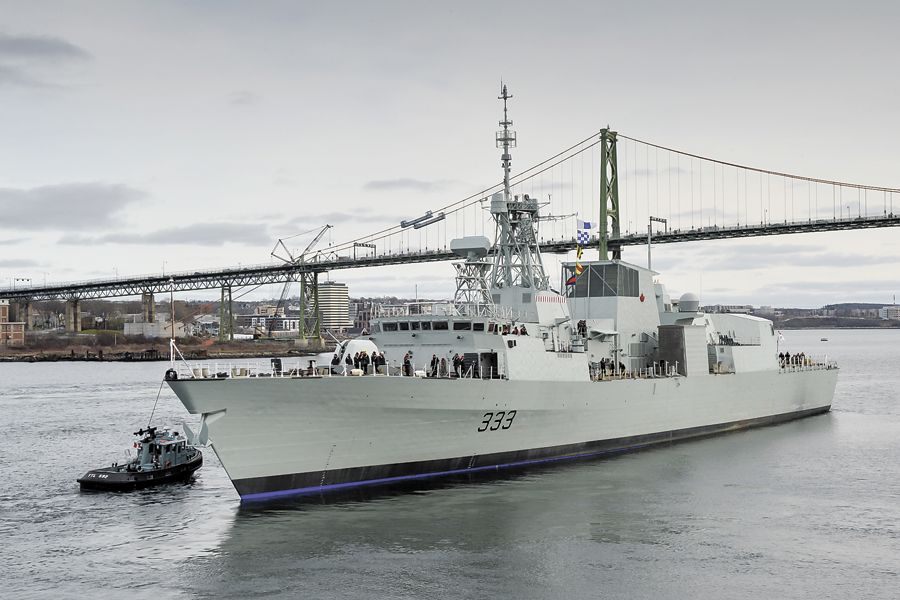Warship Modernization Completed
By Lookout on Dec 16, 2016 with Comments 0

HMCS Toronto pushes off from Irving Shipyard after the ship’s ceremonial return to the fleet on Nov. 29 in Halifax, Nova Scotia. Photo by OS Paul Green, Formation Imaging Services, Halifax, Nova Scotia
Ryan Melanson, Trident Staff ~
It’s not often government officials get to tout large procurement projects as being completed on time and under budget. But those were the words of the day on Nov. 29 when HMCS Toronto returned to the Royal Canadian Navy (RCN), marking the completion of the Halifax-class Modernization (HMC)/Frigate Life Extension project.
A ceremony was held at Irving Shipbuilding Halifax shipyards, where leaders involved with the project, including VAdm Ron Lloyd, Commander RCN, gathered to mark the occasion and spread the good news.
The HCM project had a budget of about $4.3 billion, and while final total costs aren’t available, ADM(Materiel) Pat Finn said a portion of that budget is already being returned.
A number of speakers focused on this point in their remarks at the ceremony, including Finn, VAdm Lloyd, and Halifax MP Andy Fillmore.
VAdm Lloyd said trust and communication with stakeholders and the public is important, and communicating this project is a way to show that government and industry can cooperate to deliver high-quality equipment with cost efficiency.
“When Canadians take a look at their shipbuilding industry now, they can be proud of another success story,” he said.
The goal of the HCM/FELEX project, which began more than a decade ago, was to see all 12 Halifax-class frigates undergo refit and installation of modern equipment to allow sailors to continue to work in defense of Canada at home and abroad. The process involved Irving Shipbuilding on the East Coast, Seaspan Shipyards on the West Coast, Lockheed Martin Canada, and more than 30 other firms working with the Government of Canada.
The result is a fleet of ships more prepared to bridge the RCN to the eventual delivery of the Canadian Surface Combatants. The modernized frigates have been fitted with enhanced radar and electronic warfare systems, upgraded communications, and missiles that integrate with a new combat management system.
“We basically changed out two brains of the ship,” VAdm Lloyd explained. “The Combat Management System, the manner in which you fight with the ship, is completely new, and then the Integrated Platform Management System, which looks after the propulsion and other maritime engineering aspects, is also brand new and state-of-the-art.”
Irving Shipbuilding President Kevin McCoy highlighted the economic benefits of the work being done in Halifax, including an estimated $265 million in employment income in Nova Scotia through HCM, while Seaspan President Brian Carter and Lockheed Martin Canada President Rosemary Chapdelaine also spoke about their own involvement in the project.
Finn delivered a big thank you on behalf of government, both to the many industry partners who took good care of the ships and returned them in top shape, and to the crew themselves, who will be in charge of taking the newly equipped ship to sea.
“We’re inspired by your work and appreciate your enthusiasm, dedication and professionalism, and we thank you for what you do in service to Canadians every day,” Finn said.
VAdm Lloyd also pointed out the significance of HMCS Halifax currently undergoing its docking work period at the shipyard, years after being the first ship to undergo HCM.
“As the last comes out, the first goes back in, just like it should. It’s an excellent bookend for what this project represents and it’s indicative of success,” he said, noting that other successfully modernized frigates HMC Ships Vancouver, Fredericton and Charlottetown are currently deployed around the world doing the business of the navy.
Earlier in the day, Cdr Steve Archer, Toronto’s commanding officer, officially signed for care and custody of the ship from Irving Shipbuilding and following the ceremony at the shipyard, he and his crew marched on board and officially put the last of the Halifax-class back in the hands of the Atlantic Fleet.
Filed Under: Top Stories
About the Author:





